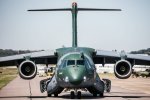Bilal Khan (Quwa)
SENIOR MEMBER

- Joined
- Aug 22, 2016
- Messages
- 7,004
- Reaction score
- 97
- Country
- Location
There are a couple of issues happening:Wonder, why we didn't, go for the Chinese option, Tho I do understand that this Cargo Workhorse has been a mainstay for quite a number of years and we have the necessary infrastructure to support this, but I would still think about long-term strategy to move towards more Chinese system for more homogeneity
1. The PAF wants to expand its airlift fleet, not just replace older planes. When expanding a fleet, you'd want to get more mileage out of your existing overhead (i.e., training, logistics, maintenance, etc infrastructure) by having it support more planes.
2. The cost of adding these used C-130s is really low because Belgium is trying to offload them and the PAF already has the full supporting infrastructure.
Basically, the PAF knows exactly how to fly these C-130s, so there's no major cost to adding more of these aircraft. However, when you switch to a new-gen platform, you have to build the training, maintenance, and even some infrastructure (like hangars) all from scratch, which adds to the cost of buying that aircraft.
That said, I do think the PAF will acquire a new-gen transport aircraft, but way, way down the line (like the 2030s or 2040s). Over time, it'll become more and more expensive to operate the legacy C-130s. The pool of spare parts, fly-worthy aerostructures, etc, is gradually dwindling.
If the PN had to initiate a successor to the P-3C in the form of the Sea Sultan LRMPA, then the PAF will eventually have to do the same thing for the C-130. To be honest, I think the best bet for replacing these C-130s would be the Embraer C-390. However, this matter isn't going to catch on for real until after 2030, and it'd have to be for like 24 aircraft (i.e., a $5B+ USD program).





